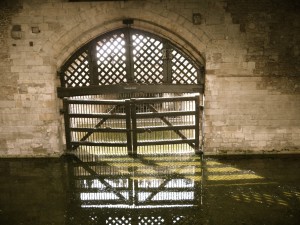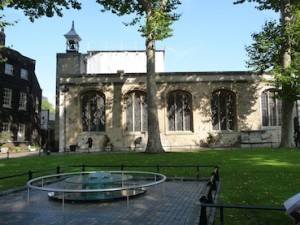On 10 February 1542, Queen Catherine Howard, dressed in black velvet, was escorted from Syon to the Tower by water. The Lord Privy Seal accompanied her, as did members of the council, guards and servants.
Eustace Chapuys, the Imperial ambassador, described the scene,
‘The lord Privy Seal, with a number of Privy Councillors and servants went first in a great barge; then came the Queen with three or four men and as many ladies, in a small covered barge; then the Duke of Suffolk, in a great barge, with a company of his men.’
As Catherine passed under London Bridge, the severed and rotting heads of Thomas Culpeper and Francis Dereham provided a gruesome reminder of what was in store.
The Queen’s barge came to a stop at Traitor’s Gate and from here she was escorted to her prison chamber with the deference due to a queen. At this stage Catherine was unaware of when her execution would take place and so she no doubt spent sleepless nights awaiting this news.
Finally, on the evening of 12 February, Catherine Howard was told to ‘dispose of her soul and prepare for death’ (Baldwin-Smith, Pg. 188) – she was to die at nine o’clock the next morning.
According to Chapuys, Catherine requested that the block be brought to her so ‘that she might know how to place herself.’ Her request was granted and the block brought into her chamber. It’s difficult to not feel pity when imagining the young queen rehearsing her final tragic public appearance.
On the morning of February 13 1542, in front of a crowd of councillors, lords and foreign ambassadors, Catherine Howard was assisted to the scaffold. Among the witnesses was the Earl of Surrey, the Queen’s cousin, who in 1547 would face the same grisly end. Charles de Marillac, the French ambassador, commented on her debilitated state but as David Starkey points out (Pg. 684), he was not an eyewitness:
‘The Queen was so weak that she could hardly speak, but confessed in few words that she had merited a hundred deaths for so offending the King who had so graciously treated her.’
The merchant Otwell Johnson was present at Catherine’s execution and in a letter written to his brother, described how the queen ‘made the most godly and Christian end’ and related how Catherine asked:
‘all Christian people to take regard unto her worthy and just punishment with death, for her offences against God and heinously from her youth upward in breaking of all His commandments, and also against the King’s Royal Majesty very dangerously.’ (Weir, Pg. 481)
After speaking the ‘customary words of edification and confession’ (Baldwin, Pg. 188), Catherine Howard knelt just as she had practised and the axe took off her head. According to Chapuys, she was beheaded in the same spot where her cousin, Queen Anne Boleyn, had been executed six years earlier.
Catherine’s ladies covered her body with a black cloak and carried her to the Chapel of St Peter ad Vincula, where she was buried and remains until this day.
References Smith, L.B. Catherine Howard: The Queen Whose Adulteries Made a Fool of Henry VIII, 2009. Starkey, D. Six Wives: The Queens of Henry VIII, 2003. Weir, A. The Six Wives of Henry VIII, 2007. ‘Henry VIII: February 1542, 16-28’, Letters and Papers, Foreign and Domestic, Henry VIII, Volume 17: 1542 (1900), pp. 46-62. URL: http://www.british-history.ac.uk/report.aspx?compid=76642 Date accessed: 17 October 2012. Entry 124. ‘Henry VIII: February 1542, 1-15’, Letters and Papers, Foreign and Domestic, Henry VIII, Volume 17: 1542 (1900), pp. 33-46. URL: http://www.british-history.ac.uk/report.aspx?compid=76641 Date accessed: 17 October 2012. Entry 100.
















I pitty Catherine and her untimely end. She did not have the brains of Anne Boleyn nor counsel to protect her. Ulitmately though the cousins suffered the same fate. You can read a letter from Catherine to Thomas at the National Archives and you can see from the writing style, spelling and other mistakes she was young, trusting and ignorant of the severity of her actions and behaviour. I would like to learn more about Catherines short life. http://www.nationalarchives.gov.uk/museum/item.asp?item_id=13
I agree Debbie, she does seem to have been uneducated in the literal sense, also unknowing on how to conduct herself as Queen and the ‘cut throat’ ways of the court.
This is only my own opinion, but I feel that her indiscretions before she married the King were known about by some of her family, and were hushed up when Henry’s for ever wandering eye fell upon her, this was all done in the interest and promotion of others, namely her family, again…she was like a lamb to the slaughter.
And although her affair with Culpepper was wrong, and extremely stupid to say the least, she doesn’t seem to have realized the consequences of her actions, like a child in a sweet shop she over indulged. I also believe the theory that Catherine had some help to carry out this affair, whether is was willing given help or not, because for a Queen to be alone would be highly improbable, if not ever. That some one did not know her every move is very odd…
This is a very sad story of a young, slighly ‘wild’ girl who enjoyed life, but was cut down before she could grow, all for the will of others. Poor Child…